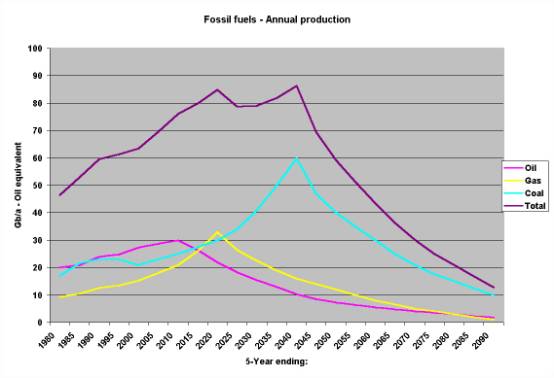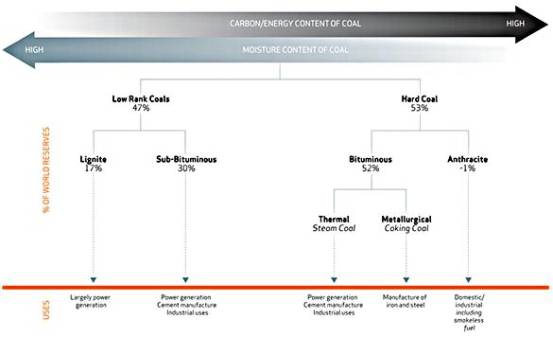
Fossil fuel Reserves
Of the three significant fossil fuel reserves of oil, gas and coal, oil provides the mobility characterising our current way of life. As finite resources, all three will be subject to the inexorable Hubbert peak cycle of a build-up in production followed by a slow decline. The most serious effect on our economies is the rising price of crude oil - and those of the related oil products, particularly liquid fuels, giving problems to motor and aircraft manufacturing, the harbingers of the problems we face. For example, there will be insufficient jet fuel to allow the predicted increase in air traffic assumed by Boeing and AirBus.
The energy industry has
taken cognisance of the need to replace oil as the principle provider of liquid
fuels by developing gas-to-liquid (GTL) and coal-to-liquid (CTL) processes.
Although both these processes work, the actual thermal efficiency is low. The
actual practical results are difficult to elicit as they are kept as commercial
secrets. BP ran a GTL pilot plant in Alaska, but declined to reveal the
performance. Sasol in South Africa has run CTL processes for many years, but
press releases fail to relate the liquids output to the coal input.
As far as can be
ascertained, GTL is around 50% thermally efficient and CTL around 40%. This
means that the deployment of processes to convert natural gas and coal to petrol
and diesel will empty the reserves faster than the use of the gas and coal to
provide energy as heat.
A possible scenario is
illustrated in a plot of oil, gas and coal based on barrels of oil equivalent in
Figure 1 .

Types
of coal and reserves
It is a common
misconception that there are hundreds of years of coal still to recover, whereas
the situation is complex. The assumption is that if we can capture and
sequestrate the carbon dioxide produced by its combustion, coal can continue to
provide most of our electricity while ameliorating its effect on climate change.
Coal is also an essential ingredient in steelmaking and could provide an
alternative to petrochemicals.
Figure 2 is from the
World Coal Institute’s website (1)

The heating values of the
various types of coal vary widely depending on their carbon and water contents.
The best is anthracite (<1% of reserves) at 27-30 megajoules/kilogram, next
is bituminous (52% of reserves) at 27 MJ/kg, sub-bituminous (30% of reserves) at
20 – 28 MJ/kg and the lowest ranking lignite (17% of reserves) at 15-19 MJ/kg.
The average heating value of the reserves works out at around 24MJ/kg. So the
amount of coal used to produce a certain volume of liquid fuel depends on its
origin.
BP provides an assessment
of coal reserves in its annual statistical review of energy. In the 2009 version
the reserves at the end of 2008 (at the then level of production) were forecast
to last for 122 years. (2) However if coal is increasingly used to substitute
for crude oil in the production of liquid fuels at the low conversion
efficiencies anticipated, the arrival of a peak in coal production before
mid-century can be envisaged. If hypothetically all the remaining coal was used
for production of liquid fuels at 40% conversion efficiency and there was a
market for the products, it would be gone in 50 years. Assuming that a good
proportion of the remaining coal is used for the production of liquid fuels, a
coal production peak around mid-century is a realistic prospect. See EWG’s
Report (3)
Inefficiency
of generation with CCS
MIT published an
exhaustive report “The Future of Coal” which examined the various
technologies for carbon capture and sequestration (CCS). (4) There is an
economic penalty in adopting clean coal technologies as more coal is needed to
provide the additional energy for the ancillary processes for the separation and
sequestration of the carbon dioxide.
Reference to Table 3.1 on
page 19 of its Chapter 3 – Coal-Based Electricity Generation shows that for
the same generation and additional 27% to 37% of coal is consumed, dependent on
the technology used and assuming a higher heating value for the coal of 25.35 MJ/kg.
Moreover the extra capital for a new CCS plant is considered to be from 60% to
74% more than a conventional station. However there is an exclusion below the
table “Does not include costs associated with transportation and
injection/storage”.
Adding the cost of the
transport pipework and injection equipment it must be concluded that a
coal-fired generation plant incorporating CCS would cost twice as much and use
50% more coal than a conventional plant. It would also mean that the remaining
coal reserves dedicated to generation would be depleted by a third.
Retrofitting is shown in
the MIT report to be impractical, but even it were, the additional capital
required and the reduction in revenue by a third would bankrupt existing
coal-fired station owners.
It is
assumed that in most cases CO2 injection will be into existing or
depleting oil and gas wells to enhance the recovery of oil and gas. As around
two-thirds of the injected CO2 returns to the surface with the oil
and gas it would then have to be separated and re-injected. Permanent CO2
injection can lead to a build-up in reservoir pressure and eventually lead to
leakage. (5)
It seems
highly unlikely that CCS will ever be applied to a full scale coal-fired
station.
CO2
and climate change
The relationship between
climate change and CO2 emissions is subject to much debate. There has
been a significant rise in emission concentrations in the last 100 years which
can reasonably be attributed to the combustion of fossil fuels. The weather does
seem to be disturbed, but whether there is an underlying warming trend is
disputed.
The decisive occurrence
is the so-called medieval warming (900 – 1300 AD) during which temperatures
were higher than at present and when there was little industrial activity. The
rapid rise in temperature in the latter years of the Mann “hockey-stick
plot” matches the rise in carbon dioxide emissions, but the veracity of its
“proxy” temperature estimates is challenged and the IPCC is accused of
masking the medieval warming rise from the plot. In the last 10 years or so
sceptics have claimed that temperatures have dropped, so an assessment as to
whether this is but a temporary “blip” in a continually rising trend has to
await events over the next decade or so.
The argument has to be
settled, because if climate change, real or imagined, is independent of
anthropogenic emissions, then the case for CCS fails..
Emission
reduction by depletion of fossil fuel reserves
If climate change is
caused by carbon dioxide emissions, or partially so, then the progressive
depletion of fossil fuel reserves will alleviate it somewhat. The reduction in
emissions will perhaps not match the levels required in the Kyoto and Copenhagen
protocols, but certainly by the end of the century there will be just a modicum
of coal remaining. To worry about a temperature rise in 2100 from fossil fuel
combustion is somewhat far-fetched if by then there is little fuel to burn!
In contrast, the various
reports assume no reduction in fuel availability and indeed imagine energy use
will expand, hence the introduction of carbon emission trading.
There is clearly no need
for carbon trading as the depletion of fossil fuels will progressively raise the
cost of current economic activity and reduce it. Depletion may lead to global
economic collapse or force an alternative energy-lean lifestyle on those
societies able to adapt.
Future
contribution of renewables
There is little doubt that renewables will be unable to match the current or envisaged need for energy. In any case electricity demand will decline as the motor and aviation industries decline due to escalating fuel costs. Renewables will be mostly associated with micro-generation as localisation movements get under way as a response to restrictions in movement.
Large centralised power plants, such as nuclear and CCS coal (and large off-shore wind farms) require additional power transmission lines. Much depends on the creation of pumped storage schemes to compensate for the variability of wind and solar. There are also molten salt heat storage systems. If the variability can be reduced locally it will reduce the capacity of the associated transmission lines.
Some transmission lines may be made unnecessary depending on the degree of self-generation from residential solar power and domestic micro combined heat and power (CHP) boilers and of course the severe reduction in demand as movement of people and goods decreases in volume.
As oil, gas, coal and also uranium as well as the materials needed for construction are all subject to depletion, the survival of developed societies depends on their ability to adjust to a low-energy lifestyle.
Biomass,
solar, wind, marine energy
The problem with energy
crops that they are in competition with food crops for land use and for
oil-based fertilisers, insecticides, herbicides and fungicides, all of which
will be in short supply. Fuel crops can be grown in hydroponics greenhouses
heated and lit by CHP and with enhanced CO2 atmospheres to increase
yield, thus avoiding conflict with organic farms over land use.
Solar water heaters are
effective and increasingly being installed, while solar photo-voltaic systems
will benefit from the new feed-in tariffs. It is unlikely that major schemes
like those in Spain and Nevada and as proposed in North Africa will be installed
in Northern Europe. There may be huge solar generator projects in North Africa
deploying orientated mirrors..
Utilisation of small wind
generators will decline, but a variety of medium size types producing 10 KW –
25 KW are likely to be installed at farms and on windswept countryside, also
benefiting from the feed-in tariffs. Off-shore wind is currently the favoured
large-scale renewable, especially as planning permission for inland wind is
increasingly opposed.
In Stanford Lough near
Belfast is a prototype large sea-current project utilising the regular tides.
(6) As tidal currents are associated with the phases of the moon and occur with
a certain regularity there may be many off-shore generating developments. Wave
power is subject to the wind and sea “fetch”. The equipment has to be very
strong as it is subject to enormous forces and erosion. So systems using
underwater sea currents may eventually predominate.
In
what should we invest?
The recent credit crunch
has highlighted the need to spend wisely and as the imposition of CCS to
coal-fired generation will accelerate the emptying of coal resources,
particularly of the best quality coals, it should be dropped from utility and
government programmes.
Basically we need to
invest in an energy descent. Society has to adjust to an energy-lean life-style
for its survival. Globalisation has to be replaced with localisation, in which
communities come together to survive the mid-century economic catastrophe
resulting from the lowering concentration of minerals and the resulting
inefficiency of capital.
© John Busby 11 March
2010
(1)
World Coal Institute http://www.worldcoal.org/coal/what-is-coal/
(2)
BP annual Statistical Reviews http://www.bp.com
(3)
EWG Coal Report http://www.energywatchgroup.org/fileadmin/global/pdf/EWG_Report_Coal_10-07-2007ms.pdf
(4)
MIT’s “The Future of Coal” http://web.mit.edu/coal/
(5) “Injecting realities” http://www.energytribune.com/articles.cfm?aid=826&idli=3
(6)
Strangford Lough http://www.pandct.com/media/shownews.asp?ID=24089